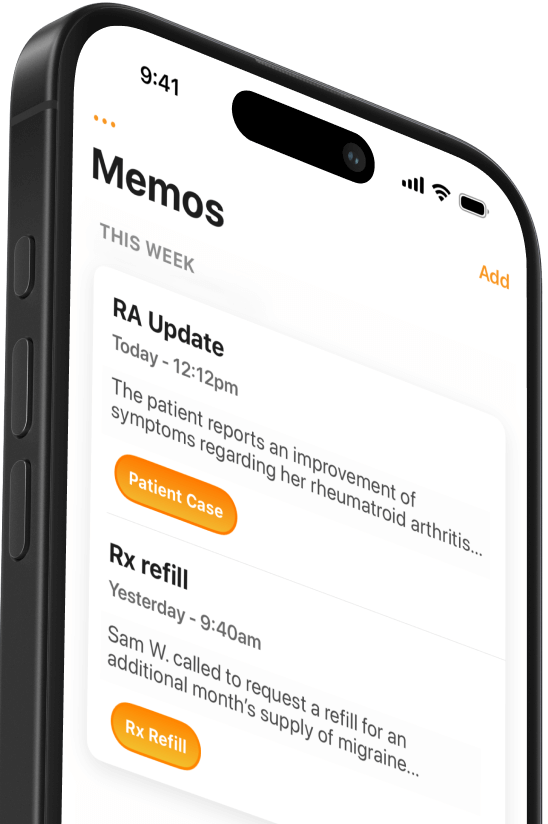Speed up your medical dictation with this simple tip
Dictate in the exam room to boost efficiency, make more accurate notes, ensure patients hear your plan, and avoid stacks of notes at day's end.


Popular articles
Medical dictation can shave off hours of documentation time each week if you have the correct workflow. However, developing a system that allows you to get your notes done before leaving the office takes time and practice. What tips can you glean from physicians who have figured it out?
One of the simplest yet least-discussed dictation best practices is to complete your dictation while you’re still in the exam room. We hear the same thing from many physicians: dictating notes during patient visits makes it possible to keep up with a heavy documentation load while producing excellent results.
Make medical dictation easier
If you use medical dictation to complete notes, you’ve likely encountered one of these workflow challenges:
- You carry around written notes and keep track of them until you have time to dictate them into the EMR.
- Recalling patient details is slow because of the time lag between visits and documentation.
- You get stressed thinking about the backlog of documentation that builds up throughout the day.
- Patients send you follow-up questions and clarifications, which you need to respond to in the patient portal.
- Work infringes on your personal life because you take a stack of notes home at night to dictate after dinner.
Here’s how Robert Flaherty, MD, describes the standard approach to medical dictation in Family Practice Management:
“The standard practice is to scribble cryptic notes on a piece of paper during the patient encounter for later dictation. This is the method I followed for years. Sometimes I could decipher my notes; sometimes I couldn’t. Sometimes I couldn’t even find my notes. Often I would see several patients with the same problem but couldn’t remember the differences between them. Although I tried dictating between patient visits, I was often interrupted or got behind and would have to postpone dictation until the end of the morning or the end of the afternoon. The prospect of dictating that stack of charts caused me irritation, bordering on despair.”
Robert J. Flaherty, MD
Like many of his colleagues, Dr. Flaherty eventually realized there was a better way to do medical dictation. Simply dictate each note at the end of the visit while you’re still in the exam room with the patient.
Modern dictation tools like Mobius Conveyor make real-time dictation easy. Using your smartphone as a microphone, you can dictate directly into the EMR, whether on a nearby desktop or a mobile EMR app. Your words appear as you speak, and the app saves them instantly in the chart. You’re free to move on to the next visit.
Why dictate in the presence of your patients?
Let's look at seven reasons to try dictating in the presence of patients. Dr. Flaherty inspired our list, which reflects the feedback we often hear from physicians who take this approach to medical dictation.
1. It takes no extra time.
You have to do the dictation anyway, so why not do it immediately? Dictating in front of the patient takes about two minutes. Those minutes don’t make your visits significantly longer, but they improve patient satisfaction because you spend more time with the patient.
2. Your history and physical exam will be more accurate and complete.
Physicians who dictate during visits report that they sometimes stop partway through the dictation to ask the patient an additional question. Asking the patient improves their engagement while making the note more accurate and complete.
3. It reiterates your plan and instructions.
Do you ever wonder if your patient hears your plan and instructions? Letting them listen as you dictate allows them another chance to hear what will happen next.
4. Your patient knows you’ve heard their story.
Before dictating the subjective part of your note, tell the patient, “Stop me if I get the story wrong.” This simple statement ensures that the patient feels understood.
5. Your patient knows what you’re thinking.
When your patient hears you dictate their note, there’s no mystery about what you checked, your diagnosis, or your assessment of their condition. This openness can relieve patients, especially if they are experiencing a challenging emotional state, psychiatric diagnosis, or a severe illness like cancer.
6. It “immunizes” the chart against disputes.
Many providers end their dictation with the phrase, “Dictated in the presence of the patient.” This addition provides powerful protection in the case of a dispute.
7. It improves the quality of your dictation.
You make your documentation process educational by dictating in front of patients. Physicians say this approach to medical dictation has made their chart notes more organized and less filled with jargon. The result is a clear, understandable note that’s legible to patients and health professionals.
Related Articles


We Get Doctors Home on Time.
Contact us
We proudly offer enterprise-ready solutions for large clinical practices and hospitals.
Whether you’re looking for a universal dictation platform or want to improve the documentation efficiency of your workforce, we’re here to help.





